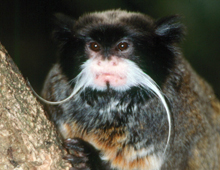Description: The Emperor tamarin has a black head, grayish-brown body, whitish underparts and an orange-red tail. They get their name from their long white mustache, that supposedly resembles that of a previous German emperor, Emperor Wilhelm II.
Size: Their head and body length is 9 to 10 inches (23-25 cm) with a tail length of 16 inches (41 cm). They weigh about one pound (0.45 kg).
Behavior: Emperor tamarin groups consists of a dominant female and at least two mature males plus offspring. The total group size averages six members. The dominant female will breed with all adult males in the group. Since it is impossible to know which is the father, all males help in the care of the young. Emperor tamarins spend much of the day foraging in the treetops.
Diet: They eat fruit nectar, gum and insects. Senses: Sight is their primary sense but they also
have a well-developed sense of smell.
Communication: Emperor tamarins communicate through a series of vocalizations. Often associated with Saddle-back tamarins, Emperor tamarins will respond to their alarm calls and vice versa. Their array of facial expressions is not as varied as that of higher primates.
Reproduction: Twins are usually born in the spring or summer after a gestation period of 140 to 145 days.
Habitat/range: They are primarily found in lowland forests in Brazil and Peru.
Status: IUCN Least Concern (LC); CITES Appendix II.



